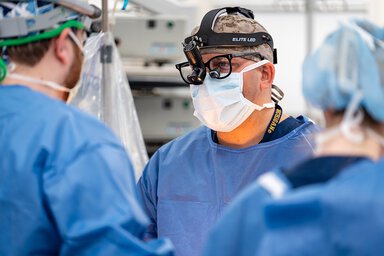What cancers are included in the Next-Day Access program?
The Next-Day Access program includes stomach (gastric) cancer, small intestine (small bowel) cancer and hepato-pancreato-biliary (HPB) cancers. HPB cancers include liver cancer, pancreatic cancer, gallbladder cancer, bile duct cancer, retroperitoneal sarcomas and rare tumors like neuroendocrine tumors and gastrointestinal stromal tumors (GIST).
Stomach Cancer
Stomach cancer is relatively rare in the U.S. Risk factors include smoking, a family cancer syndrome, obesity and gastroesophageal reflux disease (GERD). Early signs of stomach cancer can include indigestion, bloating, nausea or heartburn. Signs of more advanced stomach cancer can include stomach pain, dark red stool from bleeding, unexplained weight loss, difficulty with swallowing or jaundice (when the whites of your eyes and skin turn yellowish).
Small Intestine Cancer
The small intestine is divided into three parts – the duodenum, jejunum and ileum. Cancer can start in any of these areas, but most commonly starts in the duodenum, the part that connects to your stomach. Overall, though, small intestine cancer is rare. Symptoms can include pain in the abdomen, dark red stool from bleeding, unexplained weight loss or nausea.
Liver Cancer and Bile Duct Cancer (cholangiocarcinoma)
Liver cancer is uncommon in the U.S., although worldwide it is the third most common cause of cancer death. Risk factors include chronic infections with either Hepatitis B virus or Hepatitis C virus, cirrhosis, non-alcoholic fatty liver disease and heavy alcohol use.
Bile duct cancer is rare. Risk factors include several conditions that cause chronic inflammation, such as primary sclerosing cholangitis or chronic ulcerative colitis. Other risk factors include cirrhosis and non-alcoholic fatty liver disease.
Symptoms of these cancers can include jaundice (when your skin and the whites of your eyes turn yellowish), unexplained weight loss, a lump or full feeling on the right side of the abdomen under the ribs, pain on the right side of the belly or by the right shoulder, light-colored stool or itchy skin.
Gallbladder Cancer
Gallbladder cancer is rare. One of the biggest risk factors for developing gallbladder cancer is gallstones. However, most people with gallstones do not go on to develop cancer. Symptoms can include belly pain, lumps in the belly, jaundice (yellowing of the skin and whites of the eyes), nausea and vomiting.
Pancreatic Cancer
Pancreatic cancer is the 10th most common cancer in the U.S. Risk factors include smoking, obesity, type 2 diabetes, chronic pancreatitis and certain inherited family cancer syndromes. Symptoms can include jaundice (yellowing of the skin and whites of the eyes), fatigue, oily stools, unexplained weight loss, pain in the belly or back and blood clots.





